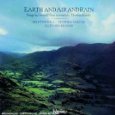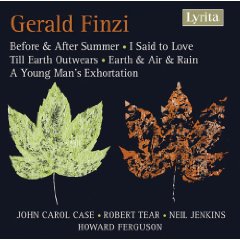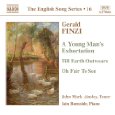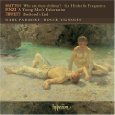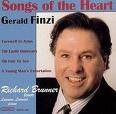Shortening Days
- Musical Analysis Section
- Audio Recordings Section
- Unpublished Analysis Excerpts
- Van der Watt - The Songs of Gerald Finzi (1901-1956) To Poems by Thomas Hardy
- Carlisle - Gerald Finzi: A performance Analysis of A Young Man's Exhortation and Till Earth Outwears, Two Works for High Voice and
- Denning - A Discussion and Analysis of Songs for the Tenor Voice Composed by Gerald Finzi with Texts by Thomas Hardy
- Rogers - A Stylistic Analysis of A Young Man's Exhortation, Opus 14, by Gerald Finzi to words by Thomas Hardy
- Bray - An Analysis of Gerald Finzi's "A Young Man's Exhortation"
- John Keston - Two Gentlemen from Wessex, The Relationship of Thomas Hardy's Poetry to Gerald Finzi's Music
Poet: Thomas Hardy
Date of poem: (undated)
Publication date: In the collection: Human Shows (1925)
(Purdy, 234)
Publisher: Macmillan Publishing Company
Collection: Human Shows, Far Phantasies, Songs and Trifles
History of Poem: Richard Purdy records the manuscript title for the poem was "Autumn [October] at the Homestead".
(Purdy, 244)
James Osler Bailey writes: "The homestead is Hardy's birthplace in Higher Bockhampton, with its living-room windows opening westward so that the sun-rays "thread . . . through" the smoke rejected by the chimney. His reference to the astonishment of sparrows when cold weather returns is characteristic."
(Bailey, 562)
Poem
(‘Shortening Days at the Homestead’)
|
||
|---|---|---|
| 1 | THE first fire since the summer is lit, and is smoking into the room: | a |
| 2 | The sun-rays thread it through, like woof-lines in a loom. | a |
| 3 | Sparrows spurt from the hedge, whom misgivings appal | b |
| 4 | That winter did not leave last year for ever, after all. | b |
| 5 | Like shock-headed urchins, spiny-haired, | c |
| 6 | Stand pollard willows, their twigs just bared. | c |
| 7 | Who is this coming with pondering pace, |
d |
| 8 | Black and ruddy, with white embossed, | e |
| 9 | His eyes being black, and ruddy his face, | d |
| 10 | And the marge of his hair like morning frost? | e |
| 11 | It’s the cider-maker, | f |
| 12 | And appletree-shaker, | f |
| 13 | And behind him on wheels, in readiness, | g |
| 14 | His mill, and tubs, and vat, and press. | g |
(Hardy, 810) |
||
Content/Meaning of the Poem:
The fire place is lit for the first time in the Autumn, and some smoke escapes into the room:
The sun's rays reflect off the wisps of smoke like the threads in a weavers loom.
Sparrows dart from the shrubbery without a care
The willows look like sea urchins
with their spines protruding
after loosing their leaves.
Who is it slowly coming,
Dressed in black with sunburnt skin and lightly covered in frost or snow,
His eyes are dark and his face is sunburnt/wind burned from being outside
The edge of his hair is white
He is the cider-maker
Also known as the appletree-shaker
He brings with him in a wagon, in preparation,
A grinding mill, tubs, vat, and a press for extracting the juice.
For additional comments as to possible meaning of the text please refer to: Content - Van der Watt.
Speaker: Simon Gatrell writes "In 'Shortening Days at the Homestead' (791), though the narrator does not introduce himself in the poem, we are conscious of his presence as he notes the details of his environment that speak of autumn. The narrator and the poet are in harmony; the composite picture is dynamic but unemphatic, complete despite its brevity."
(Gatrell, 165-6)
Setting: Hardy authorities disagree somewhat as to the specific setting for the poem. James Osler Bailey suggests that the view from the "homestead" may be simply from Hardy's window in his boyhood home in Higher Bockhampton. (Bailey, 562) F. B. Pinion suggests the location in the poem is: "Blackmore Vale, 'Pomona's Plain'." (Pinion, 228)
Purpose: Gerhardus Daniël Van der Watt suggests in his dissertation that the poem was written by Hardy in an attempt to cheer himself up before Winter was to arrive. (Van der Watt, 118) For additional comments please refer to: Background - Van der Watt.
Idea or theme: Joy, in ones later years
Style: Written in a lyrical pastoral style.
Form: Gerhardus Daniël Van der Watt writes in his dissertation: "The form of the poem is interesting in that it is a variation on the Italian sonnet. The sestet is presented first (stanza 1) with an aabbcc rhyme scheme and the octave follows with the rhyme scheme: dedegg (ending with the rhyming couplet characteristic of the English sonnet). The sestet is metrically uneven while the octave has a mixture of anapestic and trochaic metres."
(Van der Watt, 119)
Synthesis: Another poem of Hardy's that on the surface seems simple in its descriptive lines of nature and an individual but on a deeper level it has the hallmarks of one contemplating the last years of ones life. The first stanza begins describing a scene that bridges the autumn season with that of winter. The second stanza describes in detail the cider-maker character. Autumn is often used as an allegory of nearing the end of life and the cider-maker, not a typical character in poetry but nevertheless one that could represent taking stock of ones life as one considers what their legacy may be. Again, the poem on the surface seems quite innocuous in its vivid description but this is not Hardy's nature to simply describe a scene; there is always another layer that the reader must ponder and in this poem we have a familiar theme of his, and that is: "how has my life made a difference." The "cider-maker" takes the apples and reduces them to juice or more specifically apple cider and in doing so creates either a good beverage or one that is not. After the "cider-maker" line in the poem there is the descriptive title of the "appletree-shaker" suggesting shaking-up ones life or perhaps it means to simply take stock of what one has; just as the apples fall from the tree from the shaking so do the memories of ones life splayed out already for the sorting to begin and then ultimately the conclusion to be made of whether ones life possessed a good crop at harvest or a meager one.
Published comments about the poem: James Osler Bailey writes the following in his book about the poetry of Thomas Hardy: "The poem reverses Hardy's typical pattern of a gloomy final stanza. The coming of the cider-maker is a happy event, suggesting the portrait of Giles Winterborne as "Autumn's very brother" in The Woodlanders. (Chapter XXVIII.)"
(Bailey, 562)
Dennis Taylor comments that Hardy's attitude seems to be shifting in this collection of poems (Human Shows): "In 'Shortening Days at the Homestead', 'Sparrows spurt' from hedges and the willows stand like 'shock-headed urchins, spiny-haired'. Out of such extravagance, Hardy's new muse - no longer a demonic fiddler - announces himself:
Who is this coming with pondering pace,
Black and ruddy, with white-embossed, |
|
His eyes being black, and ruddy his face,
And the marge of his hair like morning frost? |
|
It's the cider-maker, |
|
And appletree-shaker, |
|
And behind him on wheels, in readiness,
|
|
His mill, and tubs, and vat, and press.
|
|
(Taylor, 151)
|
|
Taylor continues and echoes some of the same comments made by James Osler Bailey: "We are back in the world of Giles Winterbourne, 'Autumn's very brother', 'the fruit-god and wood-god' of The Woodlanders. And Hardy seems now to react like Grace Melbury reacted to Giles: 'Her heart rose from its late sadness like a released bough; her senses revelled in the sudden lapse back to Nature unadorned.' We are also back in the world of the Shaston fair and itinerant caravans whose existential gaiety momentarily brightens up Jude the Obscure."
(Taylor, 151)
Simon Gatrell places this poem with a group of Hardy's poems that he addresses as "travelling poems." In these travelling poems, Gatrell writes the narrator is normally the travelling person but he points out that Hardy used a different technique with Shortening Days at the Homestead. In this poem the narrator is "static" and simply observes others doing the travelling.
(Gatrell, 165)
✦✼✦✼✦✼✦✼✦✼✦✼✦✼✦✼✦✼✦✼✦✼✦✼✦✼✦✼✦✼✦✼✦✼✦
Human Shows, Far Phantasies, Songs and Trifles
- Collection of 152 poems written by Thomas Hardy.
- Published in November of 1925 by Macmillan and Company.
- Hardy originally conceived the title of the collection to be: Poems Imaginative and Incidental: With Songs and Trifles but by August of 1925 he settled on Human Shows. He thought Human Shows would be easier to remember. (Wright, 153)
Gerald Finzi set the following poems within this collection:- The Best She Could [titled by Finzi as: The Too Short Time] (Before and After Summer)
- Shortening Days at the Homestead [titled by Finzi as: Shortening Days] (Young Man's Exhortation)
- Two Lips (I Said To Love)
- Waiting Both (Earth and Air and Rain)
Helpful Links:
✦✼✦✼✦✼✦✼✦✼✦✼✦✼✦✼✦✼✦✼✦✼✦✼✦✼✦✼✦✼✦✼✦✼✦
Musical Analysis
Composition date: 1928 (Banfield, 144)
Publication date: Copyright 1933 by Oxford University Press, London.
Copyright © assigned 1957 to Boosey & Co. Ltd. (Finzi, 150)
Publisher: Boosey & Hawkes - distributed by Hal Leonard Corporation
Tonality: The song begins in D minor and ends in A major. The first section of the song is unmetered and is in D minor. The second stanza of the poem is clearly separated from the first section by a change in tonality to the relative major, F major. The new section also utilizes 4/4 meter (see example below).
Modulation to F major with introduction to second stanza. (Finzi, 151)
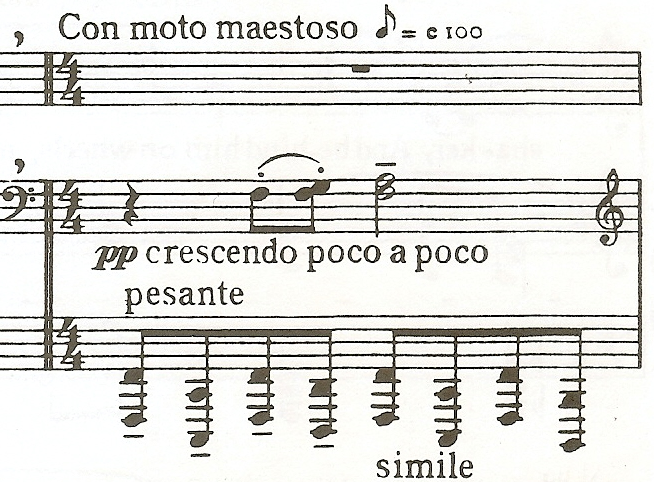
In the sixth measure a modulation is signalled with the appearance of a G major chord in the accompaniment (see example below).
Modulation from F major to A major beginning in measure 6. (Finzi, 152)

The modulation is not fully resolved until measure ten where A major is clearly indicated (see example below).
Modulation to A major complete in measure 10. (Finzi, 152)

For additional information about tonality please refer to: Tonality - Van der Watt.
Transposition: Currently unavailable
Duration: Approximately three minutes and seven seconds.
Meter: The song is unmetered in the first section but beginning with the second stanza of the poem Finzi utilizes 4/4 meter for the remainder of the song. For additional information about the meter please refer to: Metre - Van der Watt.
Tempo: At the beginning of the song Senza misura is indicated with the eighth note equalling c. 84. A poco ritard occurs in the second system with the text "woof-line in a loom. A tempo is indicated immediately after the word "loom." A ritard is indicated in the fourth system with the text "for ever, after all." A tempo is indicated at the beginning of the fifth system. Con moto maestoso is indicated at the beginning of the metered section of the song with the eighth note equalling c. 100. For further discussion about the tempi, please refer to: Speed - Van der Watt.
Form: The song can be best described as through-composed with three sections. The first section or the first four systems of the song utilize a contrapuntal texture (see example below).
Example of contrapuntal writing from 1st system. (Finzi, 150)
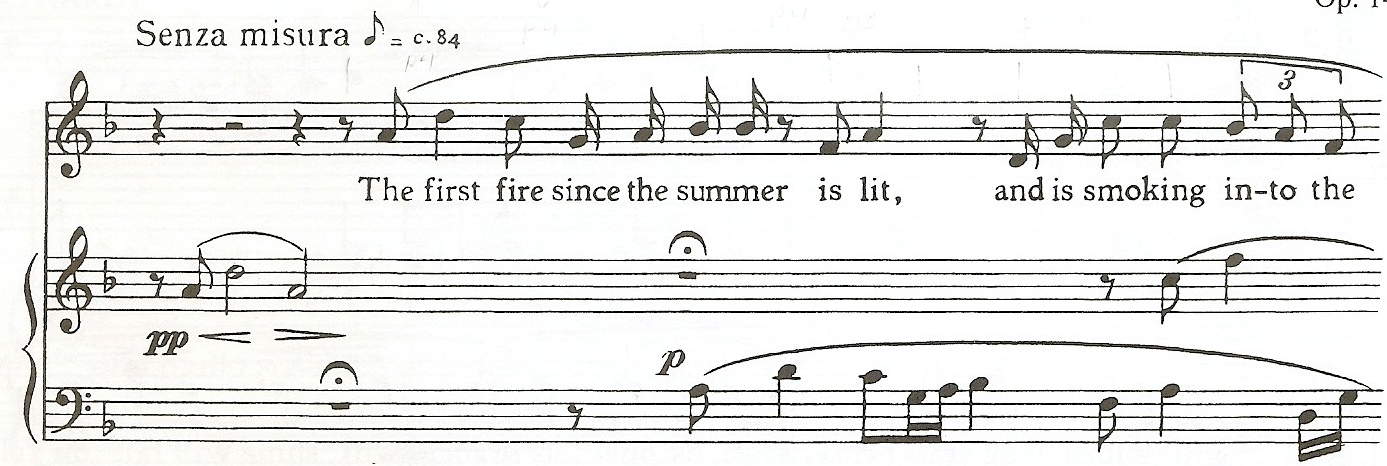
Beginning with the fifth system the texture changes to homophony, this is clearly discernible with the introduction of rolled chords in the piano accompaniment (see example below).
Second section with example of homophonic writing in 5th system. (Finzi, 151)

The last section which also coincides with the modulation to F major as well as the use of 4/4 meter returns to the contrapuntal texture. This last section is also characterized by a bass line exhibiting octaves for the first four measures as well as a rhythmic pulse based on the eighth note (see example below).
Last section with example of active bass line. (Finzi, 151)

For additional information about the specific sections of the song and other information about the form please refer to: Structure - Van der Watt.
Rhythm: The rhythms written in the song utilize shorter duration values than most of Finzi's songs. For example the use of 64th notes in the piano accompaniment and frequent use of 16th notes for the vocal line are not typical for Finzi. The shorter note values bring more drama to the song and the shorter note values in the last section coupled with the active bass line, give the impression of a faster or up-tempo song. The text-setting is primarily good but there are examples of less than stellar settings in the song. For example the words "urchins" and "pollard" in the 5th system are written with an even duration for both syllables and this doesn't seem idiomatic (see example below).
Text setting in 5th system. (Finzi, 151)

For additional discussion about the rhythm and the rhythmic motifs of the song please refer to: Rhythm - Van der Watt.
A rhythmic duration analysis was performed and for the results please refer to: Rhythm Analysis. Information contained within the analysis includes: the number of occurrences a specific rhythmic duration was used; the phrase in which it occurred; the total number of occurrences in the entire song.
Melody: There is melodic material imitated in the first system between the piano and the voice but the imitation does not last for long as both go their separate ways (see example below).
Imitation between piano and voice in 1st system. (Finzi, 150)

The vocal line is typical for Finzi but there is a slight increase in the use of small leaps in the first section of the song. For example, Finzi, normally uses step-wise motion with small leaps, this is by and far the writing one will find in "Shortening Days" but if one observes the "imitation example" above, one will see there are eight small leaps within sixteen pitches which in comparison to the remainder of the song is slightly more active with regards to small leaps. The first section is pale in activity when compared to the bass line for the metered section but by this point in the song the vocal line has adopted a more typical Finzi melody with more emphasis on step-wise motion and less on leaps. For additional information about the melodic material within the song please refer to: Melody - Van der Watt.
An interval analysis was performed for the purpose of discovering the number of occurrences specific intervals were used and also to see the similarities if there were any between stanzas. Only intervals larger than a major second were accounted for in the interval analysis. For a complete description of the results of the interval analysis please see the table at the bottom of the page or click on: Interval Analysis.
Texture: The song posses both contrapuntal writing as well as homophony. As was stated above in the Form section, the song begins with a contrapuntal texture for the first four systems at which time a homophonic, chordal texture is adopted in the piano accompaniment this gives way to an active bass line that is contrapuntal in nature while retaining the chordal or homophonic texture of the previous section in the left hand of the piano accompaniment. For a brief description about the texture including a table outlining the types of texture and the percentage in which they were used please refer to: Texture - Van der Watt.
Vocal Range: The vocal range spans an interval of a perfect twelfth. The lowest pitch is the D below middle C and the highest pitch is the A above middle C.
Tessitura: The song has a one octave tessitura from the F below middle C to the F above middle C. A pitch analysis was performed for the purpose of accurately determining the tessitura and for the complete results please refer to: Pitch Analysis.
Dynamic Range: The dynamic range is from pianissimo to triple forte in the piano accompaniment. The only indication for voice occurs in measure seven where crescendo poco a poco is indicated. Much of the beginning dynamic marks for the piano are possibly too soft for the voice and especially so at the beginning of the second measure in the metered portion of the song. For a discussion about dynamics including a table listing where each dynamic is indicated within each stanza please refer to: Dynamics - Van der Watt.
Accompaniment: The piano accompaniment is quite active and difficult throughout the song. The first section is not as active but it is made more difficult because of the lack of meter. The last section of the song is extremely active and at the same time one must balance the dynamics so as to not overwhelm the vocal line. For specific information about the accompaniment please refer to: Accompaniment - Van der Watt.
Pedagogical Considerations for Voice Students and Instructors: The range is quite good for the tenor voice and there should be little trouble negotiating the tessitura for the first two-thirds of the song. Beginning in measure eight of the metered portion of the song the range, tessitura, and dynamics become more difficult. The greatest difficulty one will possibly have to overcome in the last three measures is one of not pushing the voice as one attempts to get louder. The task is made more difficult due to the tessitura shifting to the passaggio region for these last three measures. A possible solution if one begins to detect a tendency to push or press on the voice would be to monitor the release of "readiness," and "tubs." If one takes a breath between these words attempt to release the extra breath with the consonant [s]. When attempting to release the breath in these last measures be mindful of the chest and do not allow it to fall or heave when taking a breath. While singing the high [A] on the word "press" be careful to articulate lightly the [p] consonant so as to not build-up too much back pressure. If the crescendo of the high [A] is difficult monitor ones resonance being careful to detect the placement of the tone. A good question to ask is: does the note live predominantly in the back of the oral cavity or does it have expansion to the hard palate? If the resonance seems back try mixing some [i] vowel while making the crescendo. If the sound is very forward the larynx may be elevated as well. Try mixing some [U] vowel (as in boot) to help relax the larynx.
Dr. Mark Carlisle records in his dissertation the following observations and advice: "Most of the first section must be performed with a fairly regulated and consistent tempo, but the beginning of the second subsection in system three is more suited to a recitative approach given its homophonic nature. The third section also lends itself to a slightly more flexible style of vocal delivery, not as free as recitative, but also not as restricted as the first subsection for instance. However, with the return of contrapuntal qualities in the fourth system, the tempo must again become more consistent." (Carlisle, 139)
"The comparative brevity of this piece belies its more substantial interpretive difficulties, and in this case, such factors as dynamic and tempo markings are only a beginning, particularly during the first half of the song. The initial tempo marking of [quarter note] = c. 84 (Senza misura) is fine as a basis, but should at no time during the first systems be used to create a completely static, unyielding tempo. Certainly there are moments in all of the first six systems when a steady tempo must be observed, but when flexibility is possible, even in small and subtle ways, it should be incorporated. The dynamic markings in the first half of the song, covering a relatively small range from mezzo-piano to pianissimo, are sufficient and should be followed. The first stanza of the poem is of a more introspective nature, as the young poet merely observes his surroundings without great emotional attachment. Therefore, the interpreter should not strive for excessive dynamic variation at this point, nor an overly dramatic rendering of the text, but let the relative flexibility and simplicity of melody, rhythm, and tempo paint the portrait of a young boy in observation of the little details of his world." (Carlisle, 139-40)
"The second half of the song is much more direct, requiring considerably less subtlety and nuance, but there should still be a sense of mystery and wonderment in the delivery of the lines of the second stanza. The expressive con moto maestoso and the tempo marking of [quarter note] = c. 100 are satisfactory, but a slightly less moving tempo, such as [quarter note] = c. 88, allows for an even better sense of "ponderousness" without disrupting the musical flow. The tempo in either case should remain quite constant and steady throughout this section, and the accompanist should be very careful to observe the pesante in the left hand. It is this element in particular that supplies the wonderful sense of the cider maker with all of his large and cumbersome equipment, and therefore is of absolute necessity." (Carlisle, 140)
"The dynamic marking at the beginning of the section, that of pianissimo is an excellent means of achieving the underlying textual sense of anxious uncertainty, but the crescendo poco a poco markings in measures 1 and 7 should also be faithfully executed in order to match the poetic excitement of the realization of the coming event. The ending is straight-forward, calling for a fortissimo in the piano, and is the dramatic culmination of not only this section but the entire piece as well. Therefore, both performers should carefully gauge their dynamic change in the early stages of the section in order to achieve the necessary dramatic effect at the end. Actual volume capabilities differ from singer to singer, but it is essential that some dynamic variation and increase be available to the singer at the end of the piece if it is to have a sufficient level of dramatic effectiveness." (Carlisle, 141)
"The technical limitations of this piece as a whole are very few, but the tessitura and dramatic demands of the ending are more than a little formidable. Also, both singer and accompanist must have an empathy for not only the music, but each other as well, if the first half of the piece is to be adequately interpreted. It is not overly complex music, but it does require a musical and literary sophistication beyond the usually found in most very young voice students. Therefore, the singer of this piece should be at least an upper-level undergraduate, if not graduate student, with both sensitive interpretive abilities and the technical ability to handle the ending without excessive strain or effort. This reduces considerably the pool of those with the potential to provide an artistic performance of this piece, but for those who do, it would make a fine addition to their repertoire of English song." (Carlisle, 141-2)
✦✼✦✼✦✼✦✼✦✼✦✼✦✼✦✼✦✼✦✼✦✼✦✼✦✼✦✼✦✼✦✼✦✼✦
Below one will find excerpts from unpublished dissertations. The excerpts should provide a more complete analysis of Shortening Days for those wishing to see additional detail. Please click on the link or scroll down.
Gerhardus Daniël Van der Watt - The Songs of Gerald Finzi (1901-1956) To Poems by Thomas Hardy
Michael R. Bray - An Analysis of Gerald Finzi's "A Young Man's Exhortation"
✦✼✦✼✦✼✦✼✦✼✦✼✦✼✦✼✦✼✦✼✦✼✦✼✦✼✦✼✦✼✦✼✦✼✦
| Pitch Analysis | ||||
|---|---|---|---|---|
| pitch | stanza 1 |
stanza 2 |
total | |
highest |
A |
0 |
1 |
1 |
G |
0 |
1 |
1 |
|
F |
4 |
6 |
10 |
|
E |
1 |
10 |
11 |
|
D |
9 |
14 |
23 |
|
middle C |
10 |
7 |
17 |
|
B |
10 |
2 |
12 |
|
A |
16 |
11 |
27 |
|
G |
13 |
8 |
21 |
|
F |
5 |
7 |
12 |
|
E |
3 |
0 |
3 |
|
lowest |
D |
2 |
1 |
3 |
✦✼✦✼✦✼✦✼✦✼✦✼✦✼✦✼✦✼✦✼✦✼✦✼✦✼✦✼✦✼✦✼✦✼✦
Audio Recordings
The Songs of Gerald Finzi to Words by Thomas Hardy
|
|
|
|
Gerald Finzi Song Collections |
|
|
|
The English Song Series - 16 |
|
|
|
Song Cycles for Tenor & Piano by Gerald Finzi |
|
|
|
Songs by Britten, Finzi & Tippett |
|
|---|---|
|
|
Songs of the Heart: Song Cycles of Gerald Finzi |
|
|
|
✦✼✦✼✦✼✦✼✦✼✦✼✦✼✦✼✦✼✦✼✦✼✦✼✦✼✦✼✦✼✦✼✦✼✦
The following is an analysis of Shortening Days by Gerhardus Daniël Van der Watt. Dr. Van der Watt extended permission to post this excerpt from his dissertation on October 8th, 2010. His dissertation dated November 1996, is entitled:
The Songs of Gerald Finzi (1901-1956) To Poems by Thomas Hardy
This excerpt comes from Volume II and begins on page one hundred eighteen and concludes on page one hundred twenty-five of the dissertation. To view the methodology used within Dr. Van der Watt's dissertation please refer to: Methodology - Van der Watt.
1. Poet
Specific background concerning poem:
"The poem comes form Human Shows (1926) and is undated. Martin Seymour-Smith has the following to say about Human Shows as a whole:"
(Van der Watt, 118)
"In June 1925 he had sent off the manuscript of the delightfully entitled, Human Shows, Far Phantasies, Songs and Trifles, at first just called Human Shows. It was published on 20 November 1926. The least substantial of his single collections, it was more light-hearted in tone - as if for the time being he was still determined to reject the charges of pessimism and gloom which were so often made against him." (Seymour-Smith, 860) (Van der Watt, 118) |
"Hardy wrote the poem, "Shortening Days at the Homestead", in an effort to dispel the gloom that he invariably felt at the approach of winter."
(Van der Watt, 118)
2. Poem
"The first stanza is a vivid description of the end of autumn. Three images are used to create the impression of discontent with the end of summer and the approach of winter: a fire that smokes (possibly due to the cold chimney), a sparrow's misgivings (personified to be appalled at the fact that winter is on its way again) and a willow bereft of its leaves (compared to a scruffy little vagabond). The second stanza employs a single image, namely that of the cider-maker. The detailed, cheerful description (black eyes, ruddy face, frosty white hair) of the "appletree-shaker" wheeling along his grinding, crushing and fermenting equipment, contrasts sharply with the bleak picture painted in the previous stanza. This is bold, forceful and positive. The joys of harvest time suddenly overshadow the gloomy advent of winter."
(Van der Watt, 118)
"The poem is in the style of a pastoral lyric."
(Van der Watt, 119)
"The form of the poem is interesting in that it is a variation on the Italian sonnet. The sestet is presented first (stanza 1) with an aabbcc rhyme scheme and the octave follows with the rhyme scheme: dedegg (ending with the rhyming couplet characteristic of the English sonnet). The sestet is metrically uneven while the octave has a mixture of anapestic and trochaic metres."
(Van der Watt, 119)
"The content of the poem, like the visual form, falls clearly into two sections: dreading winter and enjoying autumn. The atmosphere of each section is carefully controlled by the imagery and, inverting Hardy's usual procedures, the poem determinedly shakes off gloom and ends positively."
(Van der Watt, 119)
Setting
"Due to the fact that the first section is not divided into bars, reference will be made to system and beat for closer reference."
(Van der Watt, 119)
1. Timbre
VOICE TYPE/RANGE
"The poem is set for tenor voice and the specific range is:"
(Van der Watt, 119)
"The piano accompaniment's upper pitch limit is the second G above middle C up to the second-last bar where the right hand material suddenly bursts into the upper realms (third F sharp above middle C). The lower limit is B three octaves below middle C. The middle range of the piano dominates in the first six systems of the song. The second section of the song favours the lower to middle ranges except in the last two bars. The octave doubling of the bass line from bars 7 - 11 and 14 - 17, complements the text, "Who is this coming with pondering pace". The texture is thin in the first two systems, resulting in a cold and sparse sonority. The arpeggiated chords in systems 5 - 6 suggest the bare willows mentioned in the accompanying text while the warmer texture and sonority from bars 7 - 17 supports the pleasant activities associated with the beginning of winter."
(Van der Watt, 119)
"There are no indications for the use of pedal, yet the legato indications suggest that pedalling is the performer's responsibility. Legato touch is the most common indication of articulation. There are also a large number of portamento accents (s. 3⁵-⁸, 4⁷, b. 7-10, 12¹). The function in bars 7 - 10, used in the bass part (b. 7 simile), is to help create the pounding effect of the approaching cider-maker and all his equipment. Half-staccatos occur in the bass of bars 12 - 13, 14⁴ and 15²&⁴. The function of these is the same as that of the portamento accents."
(Van der Watt, 119)
"In the piano accompaniment mirrors the text closely in suggesting:"
Systems 1-2¹¹ |
A smoking fire is |
|
Systems 3-4¹ |
A darting, twittering sparrow |
|
Systems 5²-6³ |
A bare willow |
|
Bars 7-17 |
The pounding foot-fall of the approaching cider-maker and all his equipment (b. 7 pesante) |
"It is clear that the composer manipulates the elements of music for the sake of establishing an atmosphere suitable to the text."
(Van der Watt, 120)
2. Duration
"The textual metre is varied in the sestet (stanza 1) hence the lack of a time-signature. The octave (stanza 2) consists of a mixture of trochaic and anapestic metres, which has been set in a common-time time-signature. The open-ended metric construction of the first six systems results in a parlando singing style which requires a sensitive collaboration between pianist and singer."
(Van der Watt, 120)
Rhythmic motifs
Motif 1, consisting of four quavers [eighth notes] occurs 24 times in the piano and vocal parts (s. 2³, 2⁵, 2⁷, 4³, 6¹ b. 7(2), 8(2), 9(3), 10(2), 11, 12, 13(2), 16(5), 17). The motif really gains prominence form bar 7, from where it becomes not only a unifying factor but also rhythmic reinforcement of the text, "Who is this with pondering pace". Motif 2, consisting of two semi-quavers on the weak beat and a crotchet (or other value) on the strong beat occurs 15 times in both piano and vocal parts. (s. 1⁶, 1⁸, 1⁹, 1¹¹, 2¹, 3², 3⁴, 4⁴, b. 10, 11(2), 14, 15(2), 16). This motif serves as a unifying factor and has no specific relation to meaning. Motif 3 consists of the same note values but the semi-quavers are here placed on the beat - it occurs 13 times (s. 2⁵, 5⁴, b. 8(2), 10(3), 11, 12, 13, 14, 17(2). This recurrence of the motif is concentrated in the second half of the song and helps to create rhythmic unity and a sense of movement in an otherwise fairly metric context. The function of motif 4 is related to that of motif 3. It consists of four semi-quavers and occurs 10 times, mostly in the piano part (s. 4¹-⁵, b. 9²&⁴, 10, 11²&⁴). A last motif, associated with the darting and chirping of a sparrow (motif 5) occurs four times in systems 3 - 4 and consists of a demi-semi-quaver triplet followed by a dotted quaver tied to a crotchet."
(Van der Watt, 120)
Rhythmic activity vs. Rhythmic stagnation
"The first section of the song (stanza 1) has varied rhythmic activity. It starts out lethargically, increases towards the fourth system and then gradually slows down towards the start of the second section. This section has a more even flowing rhythmic activity throughout anchored in the quaver movement which suggests the pounding pace of the cider-maker."
(Van der Watt, 120)
Rhythmically perceptive, erroneous and interesting settings
"The following words have been set to music perceptively:"
 (Van der Watt, 120)
(Van der Watt, 120)
Lengthening of voiced consonants
"The following words containing voiced consonants have been rhythmically prolonged in order to make the word more singable:"

(Van der Watt, 121)
"The tempo indication for the first section is Senza misura [eighth note equals] c. 84. Tempo deviations are listed below:"
Bar no. |
Deviation |
Bar no. |
Return |
Suggested reason/s |
s. 2⁸ |
poco rit. |
s. 2⁹ |
a tempo |
End of first image: Smoking fire |
s. 4³ |
rit. |
s. 5¹ |
a tempo |
End of second image: Sparrow |
7 |
Con moto maestoso [eighth] = c. 100 |
Opening of second, more positive section of the song |
"Tempo indications underline the division of the song into two contrasting sections."
(Van der Watt, 121)
3. Pitch
Intervals: Distance distribution:
Interval |
Upwards |
Downwards |
Unison |
(29) |
|
Second |
34 |
27 |
Third |
8 |
13 |
Fourth |
6 |
8 |
Fifth |
2 |
2 |
Sixth |
2 |
2 |
Octave |
1 |
0 |
"There are 29 repeated pitches (or 22% of the total number), 53 rising intervals (or 39%) and 52 falling intervals (or 39%). The smaller intervals (a third and smaller) account for 111 intervals (83% of the total number) while the larger intervals (fourths and larger) account for 23 (or 175). The setting is vocally sympathetic with 83% of the vocal intervals small. A number of larger intervals need to be discussed separately."
(Van der Watt, 121)
Interval |
Bar no. |
Word/s |
Reason/s |
4th up 4th up |
s. 1⁹ |
and is smoking |
Emphasis, reinforce upward movement |
5th down 4th up |
s. 2⁶-⁷ |
through like woof |
Emphasis, visual image reinforced |
4th up 4th up |
s. 3² |
from the hedge |
Emphasis, visual image reinforced |
4th down |
s. 4² |
leave last |
Reinforce emotional content |
6th up |
s. 5¹ |
like shock |
Emphasis, reinforce meaning |
5h up |
s. 5⁶ |
pollard willows |
Emphasis |
5th down |
11¹-² |
the marge |
Change of register, emphasis |
6th up |
11²-³ |
his hair |
Emphasis |
8th up 4th down |
13¹-³ |
the cider-maker |
Emphasis, reinforce emotional content |
4th up |
14²-³ |
on wheels |
Emphasis |
5th up |
15³-⁴ |
and tubs |
Emphasis |
"The two sets of consecutive melodic fourths are noteworthy here. Both of these are used in a context where a strong sense of upward movement is suggested: "and is smoking" and "from the hedge"."
(Van der Watt, 122)
Melodic curve
"A melodic curve of the vocal line is represented below. Certain words are indicated to show the relationship between the melodic curve and the meaning:"
 (Van der Watt, 122)
(Van der Watt, 122)
Climaxes
"The two vocal climaxes are given below:"
Bar no. |
Pitch |
Word |
10⁴ |
G |
ruddy |
16³-17³ |
A |
press |
"The true climax occurs on the final note of the song. The joyous outburst at the end of the song is carefully anticipated and planned. The strong positive statement made in the second half of the poem is adhered to, particularly as a result of placing the climax on the final note."
(Van der Watt, 122)
Phrase Lengths
"The many rests used in the first section of the song allow for breathing to take place naturally. In one place the composer specifies breathing (s. 2⁶) and one other instance is suggested by a comma in the text s. 5⁵. In the fourth phrase breathing is suggested in bars 10¹ and 11¹ and in the fifth phrase bars 14¹ and 15³."
(Van der Watt, 122)
"The song starts in d minor, modulates to the relative major at the second section and to A major in the second-last bar. A summary is given below:"
Bar no. |
From - To |
Suggested reason/s |
s. 1 |
d min |
Misery as result of winter's approach |
s. 6³ |
d min - F maj |
Positive aspects of autumn, harvest time |
14⁴- 15⁴ |
F maj - A maj |
Climax of song, excitement, still brighter |
Chromaticism and Modal use
"There are a few examples of the use of chromaticism. Heightened dissonance results from the transition from F major to A major (b. 14⁴- 15⁴). A secondary dominant chord (V \ V) is used in bars 12³, 13¹, 13⁴ and an Italian chord on 13². These chromatic instances prepare the way for the modulation to A major. The anticipation of A major is further strengthened by the appearance of the C sharp on bar 14⁴. There is almost a sense of bitonality, the right hand part being in A major and the left hand part in F major."
(Van der Watt, 123)
"The first section of the song (s. 1-6³) is in d minor but the leading note is never raised. This results in tonal vagueness that creates a modal context. There is one chromatic alteration in this section, namely in system 2¹ (E flat) which results in a minor chord vii, instead of being major which would have been the case on a natural step seven."
(Van der Watt, 123)
HARMONY AND COUNTERPOINT
"The use of extended triads (mostly to the seventh but also to the eleventh and thirteenth) is characteristic of the harmonic language (v. 8-10¹)."
(Van der Watt, 123)
Non-harmonic tones
"The suspension is the most prominent non-harmonic tone used in the song. A particularly interesting case occurs in bar 14³ in the bass part: an A in octave setting is displaced by an octave to sound against chord IV and resolves to create chord ii₇."
(Van der Watt, 123)
Harmonic devices
"Fourth constructed chords in the right hand occur in a number of places, mostly localized to bars 8 - 10 (s. 3³, b. 8¹, 9², 9³ and 10⁴). The resulting dissonance is possibly intended to create a rustic atmosphere associated with the cider-maker."
(Van der Watt, 123)
Counterpoint
"Free counterpoint plays a less important role in the song due to the chordal nature of the second half of the song. There are, however, a number of imitations between voice and piano, more so in the first section of the song:"
1⁵-⁷ voice - 1⁵-⁹piano |
s. 1⁹-¹¹ voice - 1¹¹-2³ piano |
|
2²-⁶ voice - 2⁴-⁸ piano |
b. 11³-⁴ voice - 11⁴-12³ piano |
"Loudness variation is given in the following summary:"
 (Van der Watt, 124)
(Van der Watt, 124)
FREQUENCY
"There are 26 indications in the song (13 in the first six systems and 13 in the 11 bars of the second section). There is one indication for the voice (b. 13) which coincides exactly with the indication for the piano and this implies that the voice should follow the indications given in the piano part in other passages."
(Van der Watt, 124)
RANGE
"The indications range from pp to fff, the latter only occurring in the second-last bar."
(Van der Watt, 124)
VARIETY
"The indications used are:"
 (Van der Watt, 124)
(Van der Watt, 124) DYNAMIC ACCENTS
"There are no stronger accents indicated than the portamento. These are related to the "pondering pace" of the approaching cider-maker and have been discussed earlier."
(Van der Watt, 124)
"The density varies loosely between one and nine parts including both piano and voice. The thickness of the piano part is represented in the following table:"
No. of parts |
No. of beats |
Percentage |
1 part |
12 |
12.5 |
2 parts |
12 |
12.5 |
3 parts |
5 |
5 |
4 parts |
24 |
25 |
5 parts |
20 |
21 |
6 parts |
11 |
12 |
7 parts |
8 |
8 |
8 parts |
4 |
4 |
"The four- to eight-part textures account for 70% of the piano textures used in the song. This, with the exception of systems five and six, occurs in the second section of the song. The implication is that the warmer, more positive part of the song is has the thicker, warmer texture. The first two and a half systems contain a sparse one or two-part texture. This is associated with the sense of misery and discontent with the approaching winter. The thick, arpeggiated chords in systems five and six, represent the bare "pollard willows"."
(Van der Watt, 124-5)
"The structure of the song is represented in the following table:"
 (Van der Watt, 125)
(Van der Watt, 125) "The song has a clear binary structure and is therefore through composed. There is a single hint at previous material: bars 16³ - 17 recall the opening of the second section, bars 8 - 9¹."
(Van der Watt, 125)
7. Mood and atmosphere
"The atmosphere created in the song is divided into two sections: dread of the advent of winter; in section A: a thin texture, natural minor key, and parlando singing style accompanies the images of a smouldering fire and nature's dissatisfaction with the approach of winter; and in section B, rejoicing in the glories of autumn: a thick texture, major key, more melodic singing style and metrically steady movement accompanies the appearance of the cider-maker and his equipment. Gloom is conquered by joy."
(Van der Watt, 125)
General comment on style
"The setting is vocally sympathetic. The harmonic language is tonal with an emphasis on extended triads providing a type of rustic dissonance. There is a modal feeling in the A section and a strong tonal feeling in the B section. The metric construction of the song is directly related to the meaning in that the 'winter images' are presented metrically vague (Senza misura s. 1) while the 'harvest image' is metrically consistent (Con moto maestoso - pesante b. 7). The setting and control of atmosphere is the most central achievement in the song. Just as the poet does in the poem, Finzi rids the song of the gloom which he created in the first six systems and replaces it with an unusual outburst of positiveness."
(Van der Watt, 125)
Unpublished Analysis Excerpts
The following is an analysis of Shortening Days at the Homestead by Mark Carlisle. Dr. Carlisle extended permission to post this excerpt from his dissertation on September 7th, 2010. His dissertation dated December 1991, is entitled:
Gerald Finzi: A Performance Analysis of A Young Man's Exhortation and Till Earth Outwears, Two Works for High Voice and Piano to Poems by Thomas Hardy
This excerpt begins on page one hundred thirty-two and concludes on page one hundred forty-two of the dissertation.
"The full title of this poem as it appeared in its published version is "Shortening Days at the Homestead"; in the original manuscript it is entitled "Autumn (October) at the Homestead." It was published in Hardy's last volume of poems, Human Shows, which appeared in November, 1925. It contains poems written throughout Hardy's life, and was subtitled by the poet, "Poems Imaginative and Incidental; with Songs and Trifles." The setting described in this poem has been determined to be Hardy's birthplace in Higher Brockhampton. The windows there faced west, so that the rays cast at sunset would "thread" through the smoke that did not escape up the living room fireplace." (Carlisle, 132-3)
""Shortening Days" is somewhat unusual in two ways. First, it ends with an uncharacteristically cheerful stanza, since the coming of the cider-maker was a happy, longed-for event. It is much more typical of Hardy to end his poems with rather gloomy verses. Secondly, Finzi's choice of such an upbeat poem to begin Part II of this cycle, which is subtitled, "In the evening it is cut down and withers," is more than a little unusual. However, perhaps the assumption can be made that Finzi saw the fall of the year as allegorical for the autumn of life. Overall, this poem indicates a happier view of old age and death than one might expect, based upon the first five poems of the cycle." (Carlisle, 133)
Comments on the Music
"'Shortening Days' begins where the previous song left off, with a quiet opening figure in the accompaniment and no bar lines. Here, however, is where most similarities stop, for the more direct, narrative character of the poetry is similarly reflected in the music, particularly in the second half of the song. The intense, introspective diatonic bitonality of 'The Comet at Yell'ham' gives way to a modally-conceived consonance at the beginning of this song that continues to build to a highly dramatic if slightly uncommon ending. The unmetered portion, which includes the first five and a half systems, also differs from its predecessor as well as 'At a lunar Eclipse' from Finzi's set, Till Earth Outwears, in that it has a more flexible tempo than found in the other songs. Both of the other songs are fairly consistent in tempo from beginning to end; the only changes that occur are to incorporate expressive rubati. 'Shortening Days,' on the other hand, begins with a partial expressive marking of Senza misura, or 'without strict time.' There are several segments of music in these opening systems that do need consistent movement, which are handled by the remainder of the opening tempo marking of quarter note equals c. 84, but other portions are better rendered in a style similar to recitative. This characteristic is not typically found in the other songs in this cycle or in Till Earth Outwears, and therefore provides this piece with a most unusual and interesting beginning." (Carlisle, 133-4)
"Example 17. 'Shortening Days,' through ' whom misgivings appal.'" (Carlisle, 134-5) |
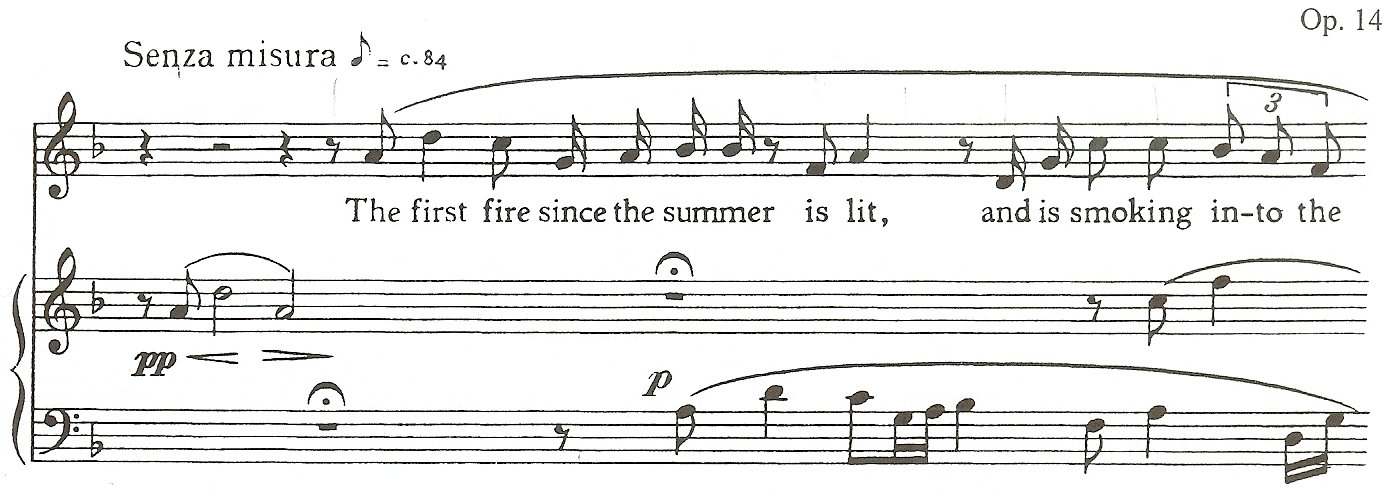


"The song is in two parts, the first unmetered, the second metered. The first part will be discussed using both the respective systems as well as the text as reference points, while the second part will use measure numbers 1-11. The opening of the piece is clearly heard in D natural minor. The first three notes heard in the accompaniment serve as a very brief motivical prelude in preparation for the entrance of the vocal line that immediately follows. The voice part enters unaccompanied, followed shortly by imitative entrances in the left hand first and then the right hand of the accompaniment. These entrances occur in the very first system, each line retaining its independence to the end of system two. This creates a wonderful three-voice contrapuntal texture to the first two systems as the music paints a beautiful portrait of 'sunrays threading through the smoke of a fire like woof-lines in a loom.'" (Carlisle, 135-6)
"Although the first five and one-half systems are basically one continuous, unmetered part, there are still three distinctive sections within this larger framework. The first is the just mentioned opening two systems of primarily contrapuntal texture that incorporates the first sentence of the poem. This section actually ends at the very beginning of the third system, but the character of the second section is already anticipated in the accompaniment at the end of system one. A brief, thirty-second note ornamental trill in the right hand at this point sets the stage for the text, 'Sparrows spurt from the hedge,' and continues well into section two. This second section, which consists of system three and all of four, is much more homophonically conceived than the first, although there is still some residual contrapuntal movement in the fourth system. Ornamental thirty-second note trills are heard four more times in this section, adding to the song a concrete element of text-painting." (Carlisle, 136)
"The third and final section of the first part covers almost all of system five and the first half of six. Rolled triads weaving through the continuing D natural minor bring the first part to its conclusion, symbolizing the standing 'pollard willows' of the text. Harmonically, this third section ends on a first inversion G-minor chord, the subdominant of the key." (Carlisle, 136)
"The vocal part in the opening section contains the most common qualities of a Finzi melody: horizontal, consonant, with a lovely balance of conjunct and disjunct motion. The vocal line in the second section becomes somewhat less 'melodious' as not values become shorter and the emphasis moves to a slightly more declamatory style. This declamatory quality becomes predominant in the third and final section, in deference to the more homophonic, recitative character that is heard. This variety of melodic styles is certainly atypical for Finzi, but it serves quite well the needs of the music within the overall structure Finzi has chosen for the first part of this poem." (Carlisle, 137)
"The second part of 'Shortening Days' begins abruptly in F major in the middle of system six. It is made distinct from the first part by the use of metrical notation and a new tempo marking, as well as the sudden change of key. This part is eleven measures long, representing a return to Finzi's more traditional chordal style, with the first constant and consistent sense of musical motion heard in the piece. There is little that is musically unique, yet the text of this second stanza is nevertheless splendidly enlivened by the uncomplicated and direct nature of the musical setting." (Carlisle, 137)
"The octave, eighth-note chords in the left hand provide the most obvious musical response to the opening line of the second stanza, 'Who is this coming with pondering pace.' The marking of pesante, or 'with heaviness,' at the beginning of this second section indicates the musical effect he sought to best represent this stanza. Although there is little complexity of rhythm, the ostinato-like quality of the left hand moving at a steady tempo still supplies the necessary sense of 'weight' to represent the coming of the cider maker with his mill, tubs, vat, and press. This is clearly one of the most important elements in the section, with the aspects of melody and harmony playing a distinctively secondary role until the last four or five measures of the piece." (Carlisle, 137-8)
"The key of F major, as previously noted, begins this part, and remains firmly entrenched until measure 6. A G chord on beat three of this measure signals a modulation via D minor to the key of A major that is not fully resolved until measure 10. Particularly unsettling are the strongly dissonant chords heard in measures 8, 9, and the beginning of 10. They create the sense of uneasiness and anxiety as might be felt by a very young boy at the coming of such an important but perhaps enigmatic person as the cider maker. However, all is resolved in measure 10 as the music literally 'explodes' into the key of A major via a plagal cadence on beats two and three of the measure. It is certainly one of the more unusual and perhaps least satisfying endings in a formal sense due to the abruptness of the resolution, but it does help to create one of the most dramatic of all endings in his songs." (Carlisle, 138)
"The vocal melody is of primary importance in this concluding dramatic effect, for while its overall structure in this section is very typical of Finzi in its balanced motion and folk-like qualities, the tessitura builds in the last three measures to a climactic ending on a¹ that produces a most powerful conclusion. It is one of the very few times that Finzi has chosen to end a song in such dramatic vocal fashion, but the excitement and happiness of the poet at the coming of the cider maker rendered it necessary for such drama. This rising melodic finish, along with the previously discussed harmonic factors and a particularly full and rich texture in the last four measures, all serve well to musically interpret the wonderful emotional sensations inherent in such a special and important occasion." (Carlisle, 138-9)
Comments about Performance
"Most of the first section must be performed with a fairly regulated and consistent tempo, but the beginning of the second subsection in system three is more suited to a recitative approach given its homophonic nature. The third section also lends itself to a slightly more flexible style of vocal delivery, not as free as recitative, but also not as restricted as the first subsection for instance. However, with the return of contrapuntal qualities in the fourth system, the tempo must again become more consistent." (Carlisle, 139)
"The comparative brevity of this piece belies its more substantial interpretive difficulties, and in this case, such factors as dynamic and tempo markings are only a beginning, particularly during the first half of the song. The initial tempo marking of [quarter note] = c. 84 (Senza misura) is fine as a basis, but should at no time during the first systems be used to create a completely static, unyielding tempo. Certainly there are moments in all of the first six systems when a steady tempo must be observed, but when flexibility is possible, even in small and subtle ways, it should be incorporated. The dynamic markings in the first half of the song, covering a relatively small range from mezzo-piano to pianissimo, are sufficient and should be followed. The first stanza of the poem is of a more introspective nature, as the young poet merely observes his surroundings without great emotional attachment. Therefore, the interpreter should not strive for excessive dynamic variation at this point, nor an overly dramatic rendering of the text, but let the relative flexibility and simplicity of melody, rhythm, and tempo paint the portrait of a young boy in observation of the little details of his world." (Carlisle, 139-40)
"The second half of the song is much more direct, requiring considerably less subtlety and nuance, but there should still be a sense of mystery and wonderment in the delivery of the lines of the second stanza. The expressive con moto maestoso and the tempo marking of [quarter note] = c. 100 are satisfactory, but a slightly less moving tempo, such as [quarter note] = c. 88, allows for an even better sense of "ponderousness" without disrupting the musical flow. The tempo in either case should remain quite constant and steady throughout this section, and the accompanist should be very careful to observe the pesante in the left hand. It is this element in particular that supplies the wonderful sense of the cider maker with all of his large and cumbersome equipment, and therefore is of absolute necessity." (Carlisle, 140)
"The dynamic marking at the beginning of the section, that of pianissimo is an excellent means of achieving the underlying textual sense of anxious uncertainty, but the crescendo poco a poco markings in measures 1 and 7 should also be faithfully executed in order to match the poetic excitement of the realization of the coming event. The ending is straight-forward, calling for a fortissimo in the piano, and is the dramatic culmination of not only this section but the entire piece as well. Therefor, both performers should carefully gauge their dynamic change in the early stages of the section in order to achieve the necessary dramatic effect at the end. Actual volume capabilities differ from singer to singer, but it is essential that some dynamic variation and increase be available to the singer at the end of the piece if it is to have a sufficient level of dramatic effectiveness." (Carlisle, 141)
"The technical limitations of this piece as a whole are very few, but the tessitura and dramatic demands of the ending are more than a little formidable. Also, both singer and accompanist must have an empathy for not only the music, but each other as well, if the first half of the piece is to be adequately interpreted. It is not overly complex music, but it does require a musical and literary sophistication beyond the usually found in most very young voice students. Therefore, the singer of this piece should be at least an upper-level undergraduate, if not graduate student, with both sensitive interpretive abilities and the technical ability to handle the ending without excessive strain or effort. This reduces considerably the pool of those with the potential to provide an artistic performance of this piece, but for those who do, it would make a fine addition to their repertoire of English song." (Carlisle, 141-2)
Unpublished Analysis Excerpts
The following is an analysis of Shortening Days by Leslie Alan Denning. Dr. Denning extended permission to post this excerpt from his dissertation on September 8th, 2010. His dissertation dated May 1995, is entitled:
A Discussion and Analysis of Songs for the Tenor Voice Composed by Gerald Finzi with Texts by Thomas Hardy
This excerpt begins on page sixty-three and concludes on page sixty-six of the dissertation.
"'Shortening Days' is another opportunity for both Hardy and Finzi to show that, while often seeming pessimistic, both poet and composer are capable of appreciating what life has to offer while still depicting realism."
(Denning, 63-4)
"Finzi is quite true to the mood of the poem as the song opens effectively in quasi-recitative. The mystery of the comet from the previous song, disappears into the stark reality of this opening. The accompaniment is sparse yet imitative of the sparrows. The quasi-recitative reaches its peak as Finzi describes bare twigs in the winter landscape. Notable is the forceful effect Finzi has here utilizing only simple triads and inversions (musical Example 10)."
(Denning, 64)
"Example 10: Shortening Days, Excerpt from opening recitative." (Denning, 64) |

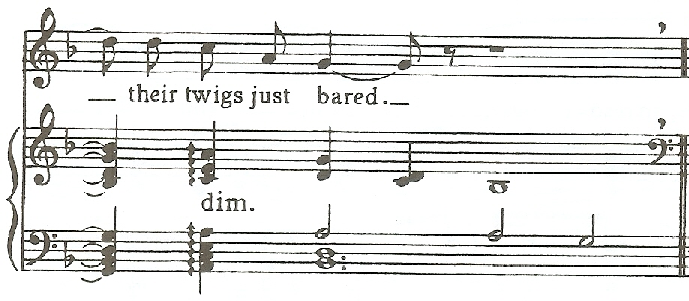
"The main part of the song which follows the quasi-recitative opens again using a Holstian bass, a favorite Finzi device, utilizing an F-major tonality and vividly depicting the arrival of the visitor. As previously discussed, Finzi's word setting is quite thorough as he shapes his melody carefully to the rise and fall of the voice. The effect is conversational and often involves feminine endings, especially when weak syllables are present (musical Example 11)."
(Denning, 65)
"Example 11: Shortening Days, Measures 7-10." (Denning, 65) |
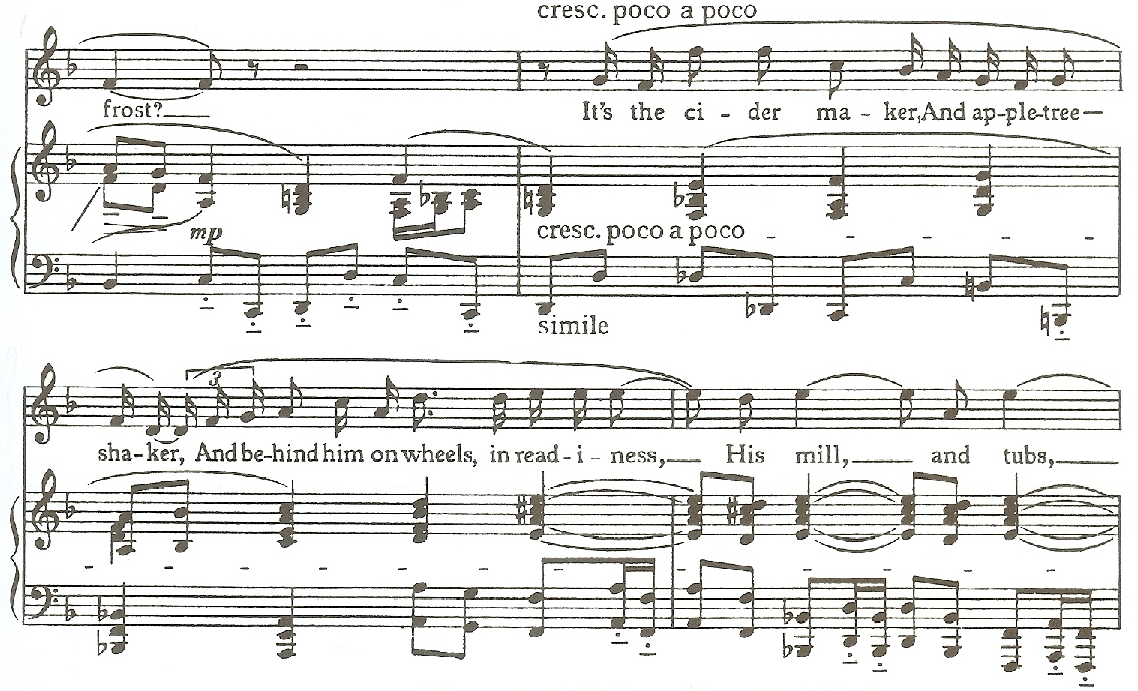
"Example eleven is a particular interesting example, for Hardy's original words were 'It is Mr. Baker the cider-maker.' This was later revised. The uplifting mood shift of the main part of the song is completed by the rise of the voice line to a climactic high a for the tenor over a strong dominant tonic cadence in the new key of A-major. The result is a song with much dramatic and varied impact. It is certainly intense for both listener and performer, a truism that the singer especially must consider and regard with respect in order to avoid too heavy an approach." (Denning, 65-6)
Unpublished Analysis Excerpts
The following is an analysis of Shortening Days by Carl Stanton Rogers. Permission to post this excerpt was extended by Dr. Rogers' widow, Mrs. Carl Rogers on March 1st, 2011. Dr. Rogers' thesis dated August 1960, is entitled:
A Stylistic Analysis of A Young Man's Exhortation, Opus 14, by Gerald Finzi to words by Thomas Hardy
This excerpt begins on page forty-three and concludes on page forty-seven of the thesis. (Rogers, 43-7)
Part II, Number 1
"Shortening Days"
The five songs in Part I of the cycle, which have been discussed in the preceding pages, deal in a general way with youth-with its feelings and loves and hopes. However, implicit in most of the poems is the sense of the transitory nature of human life. "Shortening Days," with its impressions of the coming of winter, as mentioned in the text, depicts the inevitable coming of old age.
Four general characteristics of this song are:
(a) It consists of two stanzas; it is through-composed; therefore, its form is A B.
(b) In the music of the first stanza, bar lines are not used, and the intent of the meter signature is abandoned.
(c) In the music of the second stanza, bar lines and a meter signature (4/4) are restored.
(d) The text setting is entirely syllabic throughout.
Finzi's sensitivity to the setting of the text, and especially to individual words, has been pointed out previously (See Part I, No. 1, "A Young Man's Exhortation"). In "Shortening Days," this point may be demonstrated again by the composer's setting of the word "shaker" in the sixth line of the second stanza of the poetry. The setting of this word is shown in Figure 21.
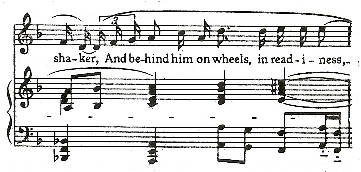
Fig. 21 -- "Shortening Days," measure 8, composer's setting of the word "shaker."
The accented syllable of the word (the first syllable) is placed on an accented part of the measure, but is given only the value of a sixteenth note. The second syllable of the word which follows is given, in effect, the longer value of an eighth note, but is not stressed because it is unaccented. This setting of the word results in an accenting of it just as it would be used in ordinary speech.
At the beginning of the first stanza, the melody of the vocal line is initiated in stretto fashion by the lower voice of the piano accompaniment. This lower imitating voice reproduces almost two lines of the melody of the vocal part, as shown in Figure 22.
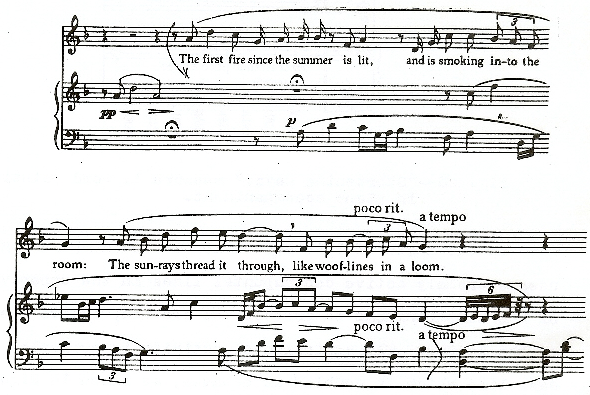
Fig. 22 -- "Shortening Days," stretto between vocal line and accompaniment at the beginning of the song.
Word painting is used at the beginning of Section B (where the use of a meter signature and bar lines is resumed) to delineate musically the words, "Who is this coming with pondering pace?" This is accomplished through the rather ponderous and marching bass line shown in Figure 23.
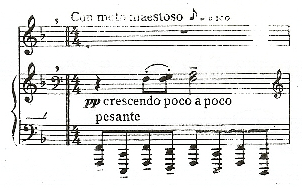
Fig. 23 -- "Shortening Days," measure 1, word painting in piano accompaniment.
In the music of this second stanza the composer again uses extremely active contrapuntal lines in the upper voices of the accompaniment to reflect the excited, active feeling of the poetry. The contrapuntal activity is supported by a bass line which is doubled in octaves, as shown in Figure 24.
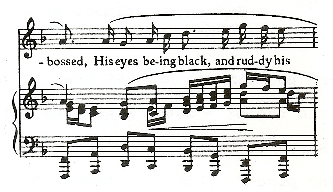
Fig. 24 -- "Shortening Days," measure 4, contrapuntal activity in the accompaniment.
The similarity between the devices used in Figure 24 and the devices used in some instrumental music of the Baroque period, especially the trio sonata, are striking. This similarity consists in the use of extremely active contrapuntal activity in the upper voices of the music, supported by a figured bass part.
Parallel chord structures, especially in the bass part of the accompaniment, are used by the composer quite frequently. They are used here at the conclusion of "shortening Days," as shown in Figure 25.
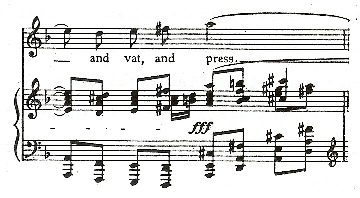
Fig. 25 -- "Shortening Days," measure 10, parallel chord structures in the accompaniment.
The preceding was an analysis of Shortening Days by Carl Stanton Rogers. Permission to post this excerpt was extended by Dr. Rogers' widow, Mrs. Carl Rogers on March 1st, 2011. Dr. Rogers' thesis dated August 1960, is entitled:
A Stylistic Analysis of A Young Man's Exhortation, Opus 14, by Gerald Finzi to words by Thomas HardyThis excerpt began on page forty-three and concluded on page forty-seven of the thesis.
Unpublished Analysis Excerpts
The following is an analysis of Shortening Days by Michael R. Bray. Dr. Bray extended permission to post this excerpt from his thesis on March 19th, 2011. His thesis dated May 1975, is entitled:
An Analysis of Gerald Finzi's "A Young Man's Exhortation"
This excerpt begins on page forty-one and concludes on page forty-five of the thesis.
(Bray, 41-5)
SHORTENING DAYS
|
||
|---|---|---|
THE first fire since the summer is lit, and is smoking into the room: |
||
|
||
|
||
That winter did not leave last year for ever, after all. |
||
|
||
|
||
|
||
|
||
|
||
|
||
|
||
|
||
|
||
|
||
"Shortening Days at the Homestead" in the manuscript is entitled "Autumn (October) at the Homestead." (Purdy, 244) The homestead is Hardy's birthplace in Higher Bockhampton, with its west facing living room windows so that "the sun-rays thread it through, like woof lines in a loom." (Bailey, 562)
The images of shortening days toward winter are very warm and simple. His reference to the astonishment of sparrows at the return of cold weather gives the whole poem an animated flavor. The poem also reverses Hardy's typical pattern of a gloomy final stanza. The coming of the "cider-maker and appletree-shaker" is a happy event.
In like manner, Finzi sets the song with much individual freedom given to the vocalist - senza misura meaning without strict beat. The opening piano figure acts as a distinct call awakening the song. The vocal line then begins alone to be followed in a fugue-like manner by the accompaniment. This constitutes a change from the other songs. Until now, the accompaniment usually starts alone and introduces not only the melodic line, but also the rhythmic motifs. Continuing, the accompaniment plays upon the melodic motifs until the next poetic image. A six thrity-second-note figure spurtingly introduces the sparrows. This flitting motif pictures the nervous looking sparrow. In setting the idea of " . . . did not leave last year, after all," Finzi introduces a

EXAMPLE 15A: "Shortening Days" measure (Third Score).
four sixteenth-note pattern, repeats it in alternating hands, ritards through the figure, and stops all motion to mimic the sparrows' disappointment. Next, the imagery of the "spiny-haired" pollard willows comes alive with regularly rolled chords. But, in picturing the twigs "just bared," Finzi once again brings the line to a stop.
In summary, the first verse of the poem contains three distinct images with three distinct sets of accompaniment. Each image constitutes a little phrase group that ritards into a cadence where all motion stops - intimating the coming dormancy of winter.
The second verse makes the transition from animated creatures (plants) to an animated human. The heavy marching octaves in the left hand give warning to his coming. The dynamic markings add another dimension to the approach of the cider-maker. The further the verse proceeds, the louder the dynamic markings are - hence, the closer the cider-maker gets. The steady marching bass octaves predominate the movement in the song. The steady rhythm is only altered by reminiscent motifs from the opening measures and by chords on the long sustained vocal note at the end.
This song seems to differ greatly from others in the cycle. The text painting takes place in the accompaniment and not in the melodic lines. In the absence of the beautifully spun melodies of other songs, the melodies in "Shortening Days" become tools for syllabic precision. Notice in
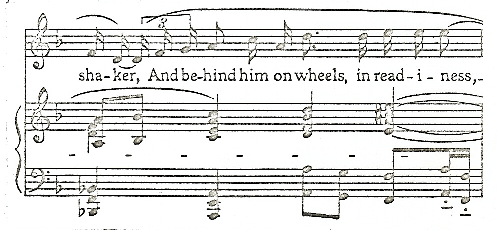
EXAMPLE 16: "Shortening Days" measure eight.
the example the naturalness of the rhythmic patterns which Finzi uses to set the poem. Each syllable is allotted one note.
The difficulty of "Shortening Days" lies in two areas. The melody has the wide range of a twelfth and presents a problem only on the last sustained note. The other problem has to do with diction. Although the tempo isn't exceedingly fast, the phrasing requires clarity and precision of both words and rhythms.
"Shortening Days" is not as well constructed as the previous songs. It lacks continuity. The phrases at the beginning seem too detached and disjointed. Although the imagery through text and accompaniment are well done, there is not a strong unifying force between them. The transition between the verses is also too disjointed. Since the techniques used in the song are different than other characteristic devices, the song should rest on its own merit. But, lack of unification stands as a weakness inherent in the construction of "Shortening Days."
The preceding was an analysis of Shortening Days by Michael R. Bray. Dr. Bray extended permission to post this excerpt from his thesis on March 19th, 2011. His thesis dated May 1975, is entitled:
An Analysis of Gerald Finzi's "A Young Man's Exhortation"
This excerpt began on page forty-one and concluded on page forty-five of the thesis.
(Bray, 41-5)
Unpublished Analysis Excerpts
The following is an analysis of Shortening Days by John Keston. Mr. Keston extended permission to post this excerpt from his thesis on September 30th, 2011. His thesis dated May 1981, is entitled:
Two Gentlemen from Wessex: The relationship of Thomas Hardy’s poetry to Gerald Finzi’s music.
This excerpt begins on page eighty-two and concludes on page eighty-eight of the thesis. To view Mr. Keston's Methodology please refer to: Methodology - Keston.
SHORTENING DAYS
|
||
|---|---|---|
THE first fire since the summer is lit, and is smoking into the room: |
||
|
||
|
||
That winter did not leave last year for ever, after all. |
||
|
||
|
||
|
||
|
||
|
||
|
||
|
||
|
||
|
||
|
||
POETIC METER
"Shortening Days" of all the poems used by Finzi in this song cycle is the most complicated rhythmically. The first line has no regular pulse, but is constructed of a spondee and four anapests. "First fire" is the spondee which is a foot of two stressed beats. The second line of the poem is an alexandrine (twelve syllables) appearing to have iambic pulsation. The third line is made up of one spondee and several anapests. The fourth line appears to be iambic heptameter, patterned after the Greek or Latin verse, containing seven feet. Line five has three iambic feet and one interpolated anapest and the last line of this stanza is treated similarly.
The second stanza is as complex as the foregoing. For the first time the dactyl pulse of a long and two short beats is used in this cycle. It is used in the first line where there are three of them. The second line appears to be made up of three trochees with an interpolated anapest. Line three has tow iambic pulses with interpolated anapests. The fourth line begins with two anapests followed by two iambic beats. Line five has one anapestic and one iambic pulse. Line six appears to employ one dactyl and a trochee. Line seven seems to be trochaic with an interpolated pyrrhic foot. Pyrrhic feet are two unstressed syllables. The last line is iambic tetrameter.
RHYTHMIC RELATIONSHIP
As with "The Comet at Yell'ham" Finzi uses no bar lines for "Shortening Days," at least not for the rhythmically complex first stanza. The dominant pulse is the eighth note, but one finds it expedient to count quarter notes dividing them into the smallest denomination, the sixteenth. The anapests in the first line as Finzi sets them are constructed with sixteenth notes for the unstressed syllables while longer note values are used for the stressed syllables. Finzi continues to use sequences of two sixteenths to deal with the unstressed syllables of the anapest and points the important words and syllables with eighth or quarter notes. The first stanza continues and concludes with Finzi's mastery of Hardy's complicated poetic rhythms. In the second stanza Finzi changes to a metered application of the text. He employs four four time here, moving along at one hundred eighth notes per minute. He conveys the feeling of the plodding of the "cider maker" pulling his handcart behind him which is loaded down with the tools of his trade.
TRANSLATION
It is hardly necessary to explain this poem, except to remind the reader that Hardy is writing of his native countryside of Dorset. Cider apples grow in abundance in the southwestern counties of England and in Victorian times the "cider maker" would visit the numerous villages during harvest time to extract apple juice from the ripened fruit for whoever needed his service. The owners of the apples paid a fee for this service and then set the liquid to ferment to make the famous West Country hard cider.
HIGHER BOCKHAMPTON
The following is Bailey's explanation of "Shortening Days" and the location involved.
Shortening days at the homestead in the manuscript is titled "Autumn (October) at the Homestead.' The homestead is Hardy's birthplace in Higher Bockhampton, with its livingroom windows opening westward so that the sun-rays 'thread. . . through' the smoke rejected by the chimney. His reference to the astonishment of sparrows when cold weather returns is characteristic.
The poem reverses Hardy's typical pattern of a gloomy final stanza. The coming of the cider-maker is a happy event, suggesting the portrait of Giles Winterborne as 'Autumn's very brother' in The Woodlanders. (Chapter XXVIII.) (Bailey, 562)
The preceding was an analysis of Shortening Days by John Keston. Mr. Keston extended permission to post this excerpt from his thesis on September 30th, 2011. His thesis dated May 1981, is entitled:
Two Gentlemen from Wessex: The relationship of Thomas Hardy’s poetry to Gerald Finzi’s music.
This excerpt began on page eighty-two and concluded on page eighty-eight of the thesis.

